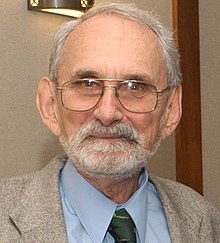Robert Curl
| Robert Curl | |
|---|---|
 |
|
| Born |
August 23, 1933 Alice, Texas, United States |
| Fields | Chemistry |
| Institutions | Rice University, Harvard University |
| Alma mater | Rice, University of California, Berkeley, PhD |
| Known for | fullerene |
| Notable awards | Nobel Prize in Chemistry in 1996. Cross-cultural ambassador at Sorbonne University UNESCO Club |
Robert Floyd Curl, Jr. (born August 23, 1933) is a University Professor Emeritus, Pitzer-Schlumberger Professor of Natural Sciences Emeritus, and Professor of Chemistry Emeritus at Rice University. He was awarded the Nobel Prize in Chemistry in 1996 for the discovery of the nanomaterial buckminsterfullerene, along with Richard Smalley (also of Rice University) and Harold Kroto of the University of Sussex.
Born in Alice, Texas, United States, Curl was the son of a Methodist minister. Due to his father's missionary work, his family moved several times within southern and southwestern Texas, and the elder Curl was involved in starting the San Antonio Medical Center's Methodist Hospital. Curl attributes his interest in chemistry to a chemistry set he received as a nine-year-old, recalling that he ruined the finish on his mother's porcelain stove when nitric acid boiled over onto it. He is a graduate of Thomas Jefferson High School in San Antonio, Texas. His high school offered only one year of chemistry instruction, but in his senior year his chemistry teacher gave him special projects to work on.
Curl received a B.S. from Rice Institute (now Rice University) in 1954. He was attracted to the reputation of both the school's academics and football team, and the fact that at the time it charged no tuition. He earned his Ph.D. in chemistry from the University of California, Berkeley, in 1957. At Berkeley, he worked in the laboratory of Kenneth Pitzer, then dean of the College of Chemistry, with whom he would become a lifelong collaborator. Curl's graduate research involved performing infrared spectroscopy to determine the bond angle of disiloxane.
...
Wikipedia
